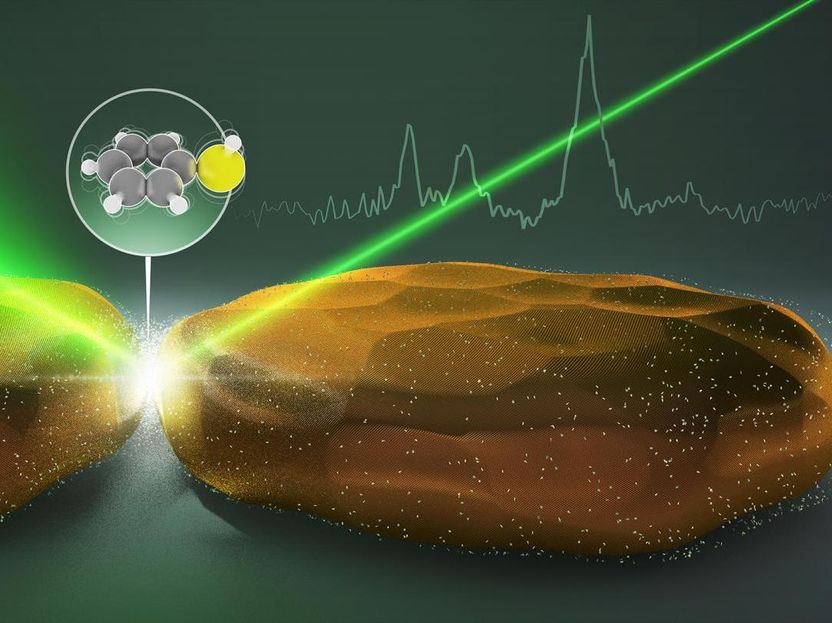Using light-force to study single molecules
Scientists at EPFL show how to amplify the sensitivity and resolution of Raman scattering
When it comes to studying single molecules, scientists use a powerful technique called "surface-enhanced Raman scattering" (SERS). An extremely sensitive tool, SERS detects the vibrations within the atoms of the illuminated molecule as a change in light color. But the sensitivity of SERS is limited at room temperature because molecules vibrate too weakly. EPFL scientists now show that this obstacle can be overcome with the tools of cavity optomechanics - the interaction between light and mechanical objects. The work has significant practical applications, as it can push the capabilities of SERS even further.

This is an illustration of light-mediated detection of a molecule.
N. Antille, EPFL
Raman spectroscopy and weak vibrations
SERS is based on the principles of Raman spectroscopy, an old technique used to probe molecules: When laser light shines on them, it interacts with their vibrations. As a result, the wavelength of the light shifts, changing its color. This shift becomes the unique fingerprint of the type of molecule being probed.
However, Raman spectroscopy is limited when it comes to single molecules because they interact very weakly with light. This happens mainly for two reasons: First, a single molecule is about a thousand times smaller than the wavelength of incoming light. Developed about forty years ago, SERS overcame this problem by exploiting a tiny cloud of oscillating electrons in metallic nanoparticles that were excited with laser light. The cloud is known as a "plasmon" and it can be localized to nanometer-size gaps where molecules can be placed.
In other words, the metallic nanoparticles act as nano-antennas that focus light down to molecular dimensions; this approach enhanced the sensitivity of SERS by more than 10 orders of magnitude. However, the second limitation of Raman has persisted without solution: molecules vibrate very weakly at room temperature - or, in technical terms, "the relevant vibrational modes are frozen".
Amplifying molecular vibrations with light
Two members of Tobias J. Kippenberg's lab at EPFL have now found a theoretical solution to this problem, showing that SERS can actually be pushed even further in sensitivity and resolution. The key in overcoming the weak vibrations is the cloud of oscillating electrons, the plasmon, which can exert a force on the vibrations of the tested molecule.
Researchers Philippe Roelli and Christophe Galland, were able to determine the exact conditions needed for this light-induced force to drive the molecule's vibrations to large amplitudes. As the scientific community has set specific guidelines for this field, the researchers chose laser wavelengths and properties of the plasmonic structures against these.
Getting more signal out of a molecule
As the light-force amplifies the vibrations of the molecule, the interaction between the molecule and the confined laser light grows stronger as well. This can dramatically increase the signal that SERS picks up, well beyond what can be reached by previously known mechanisms.
"Our work offers specific guidelines for designing more efficient metallic nanostructures and excitation schemes for SERS," says Philippe Roelli. "It can push the limits of the technique in sensitivity and resolution." By doing so, the study opens new research directions in the control of molecular vibrations with light, with potential applications ranging from biology and chemistry to quantum technologies.
Original publication
Other news from the department science
Most read news
More news from our other portals
See the theme worlds for related content
Topic World Spectroscopy
Investigation with spectroscopy gives us unique insights into the composition and structure of materials. From UV-Vis spectroscopy to infrared and Raman spectroscopy to fluorescence and atomic absorption spectroscopy, spectroscopy offers us a wide range of analytical techniques to precisely characterize substances. Immerse yourself in the fascinating world of spectroscopy!

Topic World Spectroscopy
Investigation with spectroscopy gives us unique insights into the composition and structure of materials. From UV-Vis spectroscopy to infrared and Raman spectroscopy to fluorescence and atomic absorption spectroscopy, spectroscopy offers us a wide range of analytical techniques to precisely characterize substances. Immerse yourself in the fascinating world of spectroscopy!





















































